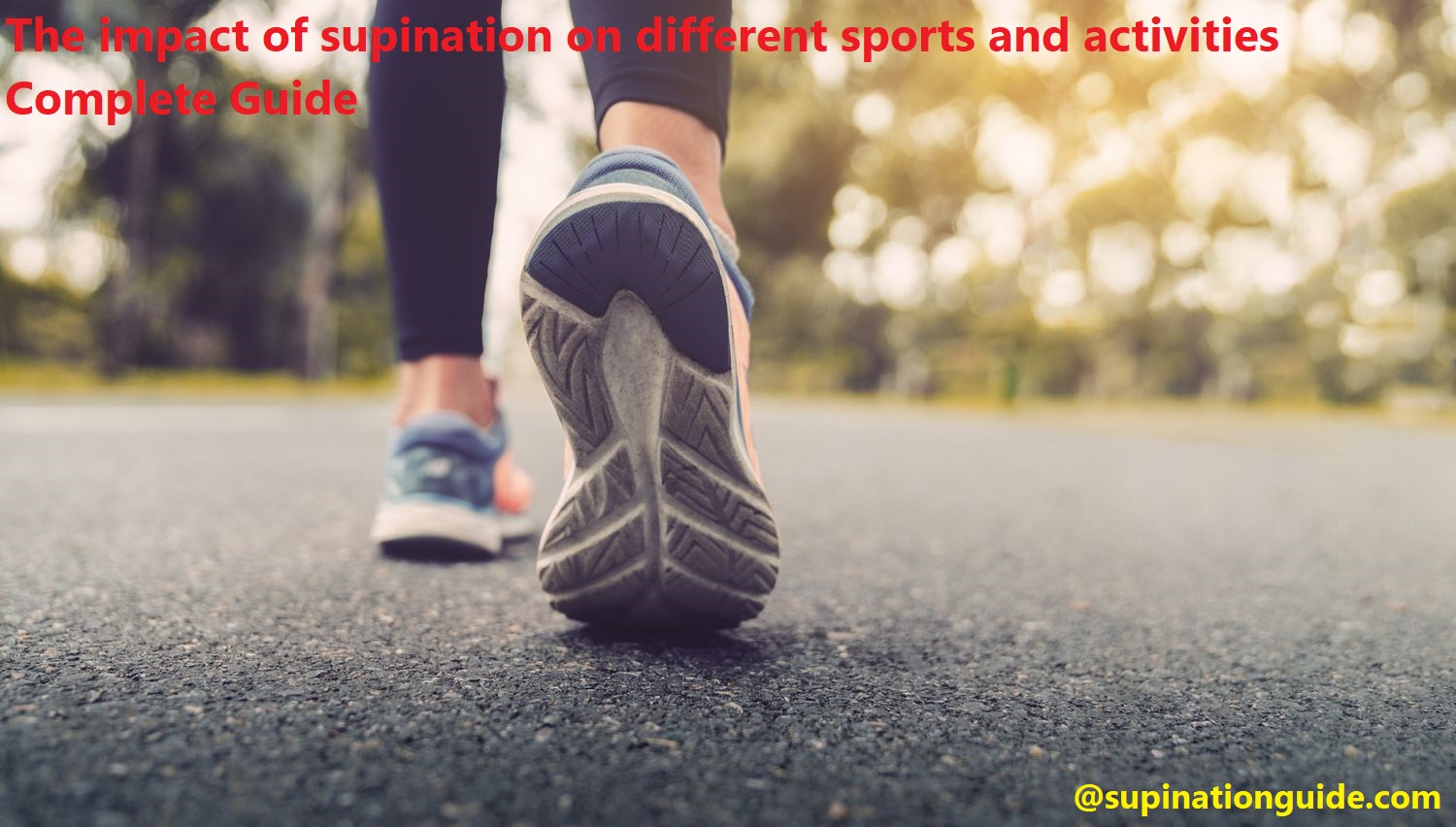Are you an athlete looking to perfect your form or a fitness enthusiast who wants to understand the importance of supination? Then this blog is for you. Here, we explore the varying impact of supination in different sports and activities such as running, biking, swimming, and more.
Get ready to get acquainted with the art of pronation and supination.
Sports and fitness activities are important aspects of good health. Taking part in regular physical activity can help to maintain or improve your physical, social and mental wellbeing, as well as reducing the risk of developing certain health problems.
Understanding how different factors such as supination can affect various sports and activities is important for optimizing performance and avoiding injury.
Supination is a type of angular motion which occurs at the wrist joint, where the forearm rotates away from the body so that the palm faces upwards. It is influenced by numerous anatomical structures including bones, muscles, tendons, ligaments and nerves. This motion plays an important role in many sports activities such as running, jumping and throwing; but too much supination can cause discomfort or strain in some individuals.
This guide looks at how supination affects different sports and activities, why it matters and how to prevent or reduce any negative impact on your performance.
Supination in Running
Supination, also known as underpronation, is a motion of the foot wherein the path of your body weight isn’t completely supported by the outside edge of your foot. This can result in more pressure being placed on the inner area of your foot and/or ankle, resulting in heel and arch pain, bunions and other issues with feet or ankles. When present during running, it’s often suggestive of an excessive pronation issue.
Running with supination can be ok if you’re wearing proper shoes that support your arches and can accommodate to some degree for the extra rolling on your inner feet. A shoe designed specifically for supinators should have a relatively rigid wedge on the medial side to help reduce its effect. It should also have decent cushioning so that when it does occur it doesn’t cause as much discomfort or stress on that area. More support at the heel can also provide greater comfort for runners with this issue.
Bear in mind that if you are a runner with supination issues you will want to switch between running shoes often in order to maintain optimal cushioning capacity while still having ample support from rigid wedges through varying terrain surfaces. Additionally, watching how fuel consumption changes over different terrains is critical when trying to determine what type of shoe will work best for you and your running style. Lastly, doing regular stretching before runs or properly warming up after them will help reduce tension in feet and ankles which will have an overall positive effect when paired with those special shoes for supinators!

Definition of running supination
Supination is the process of rolling the foot outward while running. This often occurs when the foot makes contact with the ground and distributes weight from outside of the foot to inside. The degree of supination is determined by an arch height, which can range from a low arch (those who overpronate) to a high arch (those who are normal pronators or even slightly supinate). While some runners may be unaware of their own degree of pronation or supination, many runners experience discomfort or inefficiency in running caused by their degree of pronation or supination.
The degree of running supination plays an important role in proper form and mechanics, which allows for maximal efficiency and an injury-free running experience. During the contact phase while running, pronounced supinators absorb shock differently than those with less pronounced supinating tendencies. Pronounced supinators tend to have more stress on their ankles, Achilles tendons, and calves due to improper shock absorption. Other areas that can be affected by a lack of proper form include knee joints, feet and back muscles.
Once an individual runner’s degree of pronation or supination has been determined, proper footwear can then be selected to ensure optimal performance when engaging in activities such as running and other cardiovascular exercises.
Causes of running supination
Supination, medically known as under-pronation, is a common biomechanical abnormality in which the foot rolls outward during gait. This type of running and walking pattern can lead to muscular imbalances, improper accountability of the body’s center of gravity and an increase in impact on certain parts of the body when running.
The causes of supination vary and may include structural deformities, abnormal muscle length or tightness in certain muscles, dysfunction within a joint or ligament, or environmental factors such as uneven surfaces. Structural issues most commonly linked with supination are low arches or flat feet where little cushion exists between the inside foot and the ground during walking or running gait. In some cases, this could lead to repeated sprains since the ankle joint is provided less support from muscles and ligaments surrounding it due to low arch structures.
Muscle imbalances also lead to areas of weakness which can either promote under-pronation (supination) particularly for those who lack dorsiflexion strength in their shins. Equally relevant is an imbalance between trunk stability and proximal limb coordination (glutes). If glute strength and alignment are lacking against trunk stability then this will increase over-activity within musculature around ankle joints.
Finally, environmental factors such as terrain underneath your feet while running can influence supination too – if you’re repeatedly running on uneven ground or surfaces that don’t cushion properly then you may find yourself developing issues with supination due your increased rate of offloading pressure which leads to increased strain throughout ankles, feet & lower limbs.
Effects of running supination on performance and injuries
Running supination is a type of mechanized gait in which the foot rolls over the outer edge instead of striking with the heel first. This type of running frequently results in adverse outcomes, including decreased performance and increased risk of injury.
Supination is most commonly seen in distance runners, which places excess strain on the forefoot and calf muscles, distributing body weight unevenly throughout the lower leg. This can cause weak ankles and unstable joints, increasing one’s risk for sprains or strains. Additionally, it can cause poor shock absorption for high-impact activities such as running or jumping. These mechanical issues can lead to an increased risk of plantar fasciitis, Achilles tendonitis and various forms of joint pain and irritation.
Furthermore, running supination can impact the biomechanical efficiency of an athlete’s gait cycle. Not only does pronation act as a shock absorber during heel-to-toe transitions; it also encourages a stable base for efficient movement throughout each stride cycle. Without proper shock absorption from pronation movements, athletes are more likely to experience muscle fatigue quicker than they would if they correctly pronated throughout each gait cycle. Ultimately this leads to slower times as well as a higher intensity effort at shorter distances due to excessive fatigue at closer intervals.
In order to properly treat running supination issues, athletes must re-analyze their stride patterns and make corrections that can minimize the risks of serious injuries caused by substandard strides. Weight room exercises such as calf raises can help promote proper ankle strength that encourages more balanced strides while encouraging effective foot placement when transitioning from one step to another during a run or workout session. Additionally, avoiding risky activities all together until proper adjustments have been made is recommended in order to avoid serious strain or damages caused by incorrect biomechanical movements during any exercise regimen.
Supination in Tennis
Tennis is a great example of how supination can affect technique. When performing the backhand stroke, players are often encouraged to rotate their hands so that palm faces down upon swing completion. This helps players maintain forearm pronation throughout their swing and make use of the muscles associated with this motion. This helps them generate greater power for the shot as well as generating a more consistent service motion, when serving.
The same principle holds true for forehand strokes; players utilize shoulder rotation, forearm pronation and wrist supination for optimal power and accuracy. In some sports such as tennis, volleyball, baseball and golf, it is essential to create maximum power during your swing by utilising properly timed pronation and supination in order to hit the ball with more force.
Proper body position is also highly beneficial when incorporating this technique into any activity or sport as it will allow you to generate more momentum during your movements. Thus, proper functional training which implements rotational movement drills can enhance one’s performance in activities such as tennis.
Definition of tennis supination
Supination, sometimes referred to as forefoot pronation, describes the amount of weight placed on the outside or outer edges of the feet when running or playing sports that involve quick footwork or changes in direction. This type of supination is a normal and healthy way for athletes to move on court, but for some people excessive supination can lead to problems in their feet, ankles, knees and hips.
Tennis players often rely on properly controlled supination with the outside of their foot to generate explosive speed during quick starts and dynamic stops. Excessive supination can cause distress in the muscles and tendons surrounding the ankles, knees and hips as well as cause increased wear-and-tear on certain parts of the body such as the Achilles tendon. Unlike over pronation which rotates the ankle joint from side-to-side excessively, supinating too much will increase stress in one spot along it’s range of motion which can cause stress fractures. It’s important for tennis players to recognize signs of unease when executing this motion with proper cognitive awareness on how much weight they’re putting through their foot outwardly.
To make sure you are using adequate foot positioning while training it is recommended to always start off light while adding more intensity slowly being aware of how your body is reacting to various movements. Additionally you can try different lateral support options such as stability shoes or custom orthotics currently available on the market that can help provide better support during play.
Causes of tennis supination
Supination is the outward rotation of the foot, and it can have a significant impact on a person’s game in various sports and activities. People who over-supinate tend to have higher risk of injury, such as ankle sprains.
The causes of tennis supination are mainly due to poor biomechanics (for instance, running with improper technique) and incorrect footwear, such as shoes that don’t provide adequate arch support or that are too tight around the heel area. Poor technique can also lead to excessive pronation or supination on the court during activity.
Improper technique or lack of focus on form can cause people to shift weight onto one foot and to favor one side of their body while they play. This can lead to higher risks of sprains and strains due to increased instability in those areas.

Effects of tennis supination on performance and injuries
Supination is an integral component of many sports and activities, including tennis. An understanding of the relationship between supination and performance can help prevent injury and improve performance.
Supination occurs when the foot rolls outward after landing on the ground, causing the lower leg to twist outward. This creates greater stability for the foot and allows for more force to be created during acceleration or deceleration activities. In tennis, supination is essential as it helps players traverse across court quickly and make quick directional changes without losing control.
Supination reduces stress on the body by dispersing forces from landings across a large muscle group instead of just one muscle or joint. Furthermore, it helps absorb shock when high speeds or sharp turns are performed. If supination does not occur properly, injuries such as sprains or strains may be caused due to overloading specific muscles or joints. In addition to reducing injuries, proper supination can also help maximize a player’s power output in all directions with jumps, sprints, changes in direction and serves being less taxing on the body due to better shock absorption.
In terms of improving performance through maximizing power output, focus should be placed on maintaining proper form while performing activities along with developing strong core stability that help create beautiful movements on court through improving posture during movement phases such as changing direction and accelerating/decelerating quickly and explosively while maintaining duration of play with less pain and fewer injuries due to better shock absorption when proper supinations occur every time during execution of different shots/movements/turning motions/jumps etc. Even though there is no single approach to ensure perfect supination in all situations for all players – varied drills addressing specific individual needs are best advised by experts like physiotherapists / strength coaches etc who understand best about player requirements helping them find the most effective strategy for their particular sport/activity-specific tasks helping them stay healthier, less injury prone thereby resulting in improved performances.
Supination in Basketball
Supination is a common movement in basketball that happens when athletes lack the adequate technique, fitness and strength levels. Although this phenomenon is often seen as a “weakness” by coaches and players, it can create problems in the long-term if it is not addressed.
Supination with the ball in basketball can be classified into two categories: excessive supination (more than 40 degrees of pronation/supination) and non-excessive supination (less than 40 degrees). Excessive supination occurs during ball handling activities such as dribbling, pass reception, shooting or throwing. This excessive supination can lead to pain or discomfort due to overloading of certain muscles during gameplay. On the other hand, non-excessive supination refers to an amount of internal rotation that does not cause pain.
To reduce excessive supination on court athletes should work on hip strength exercises that involve abduction and external rotation such as Glute Med Bridges or Clamshells. Gradually progressing through heavier weights with a focus on eccentric control will help develop better hip motor control and proprioception while strengthening the hips externally rotate — allowing athletes to have more control over their movements while keeping good technique.
Definition of basketball supination
Supination is a biomechanical term used to describe the position or motion of turning or rolling the foot or hand outward. This type of movement is especially significant in activities such as basketball, in which proper technique and body position are essential for success.
In basketball, supination occurs when a player places their foot on the floor in an outward direction. This action shifts their weight onto the outside of the foot and can be used to pivot or turn with greater speed and efficiency. Supination also helps keep a player’s feet from slipping, allowing them to remain balanced and prevent unnecessary injuries.
Additionally, supination helps generate power when shooting by providing increased stability through improved joint alignment. Proper utilization of supination helps players improve their performance, gain better control over their movements, enhance agility, and maintain balance on the court.
Causes of basketball supination
Supination is a condition in which the foot or ankle rolls outward or turns outwards when bearing weight. It can have a significant impact on various sports and activities, such as basketball.
Basketball requires quick pivoting, cutting, and changing directions in order to be successful; any limitation of foot mobility can substantially impact performance.
The most common cause of supination in basketball is weak muscles around the foot and ankle. If these muscles are not strong enough to support the foot while running or jumping, they will not be able to stabilize it properly, which leads to rolling outward. Additionally, insufficient warming up prior to physical activity can contribute to supination by causing stiffness and tightness in the feet and ankles. Finally, improperly fitted shoes can also contribute as they may not provide adequate arch support for the feet.
Effects of basketball supination on performance and injuries
Supination, or the certain outward rotation of the foot that can occur when running, jumping and quickly changing direction, has been linked to a number of injuries in basketball players. With supination, the foot can turn so far outward that it becomes unstable, resulting in pain and impaired performance. In order to avoid such injuries and reduce their risk factors, basketball players should understand the effects of supination on their athletic performance and how they can properly prevent injury while remaining active on the court.
The main effect of supination during basketball is instability in regions such as the ankles and knees due to too much inward or outward rotation of the foot when making quick movements. This instability can potentially lead to a wide range of injuries including ankle sprains/strains, shin splints, knee pain/inflammation, lower back pain/spasms, and other musculoskeletal issues. Long-term complications may include joint deformities and bone disorders due to weakened muscles from overuse or inadequate support from improper footwear.
Players looking to reduce this risk should begin by ensuring they wear properly exhaled shoes every time they practice or compete on court. Shoes that are too old may not be able to provide adequate support for a player’s movement patterns. Players should also pay special attention warm up exercises prior to engaging in high-intensity drills as this will help ensure proper activation of muscles used while playing basketball thereby reducing stress put upon them during game play. Additionally, participating in strength training exercises targeting key muscle groups such as calves, quads and hamstrings can help improve posture and stabilization when moving quickly around the court which will ultimately reduce injury risk resulting from supination or other biomechanical issues caused by improper form techniques.
Conclusion
In conclusion, supination is an important component of athletic performance and the overall health of an individual. It plays a vital role in protecting the feet and ankles from injury, as well as enhancing stability and agility.
As a result, it is essential that athletes and those who engage in physical activity consider how their footwear and body placement can help support or hinder their development of proper supination technique. By giving attention to foot and ankle strength, mobility, as well as making sure they are properly fitted with shoes that provide extra cushioning, people can protect themselves against common overuse injuries or other sports-related mishaps.
With the right combination of practice, education, and dedication to proper foot placement through supination training for relevant sports activities, athletes can benefit greatly from improved performance.

FAQ’s
What are the effects of supination?
Supination can lead to stress on the outer part of the foot and ankle, as well as knee and hip issues.
What is supination in sport?
Supination is a natural movement of the foot where the foot rolls outward onto its outer edge during walking, running, and other activities.
What are the benefits of supination?
Supination helps to stabilize the foot and ankle, improving balance and reducing the risk of ankle sprains.
How does supination affect runners?
Supination in runners can cause issues such as plantar fasciitis, IT band syndrome, and shin splints due to the increased pressure on the outer edge of the foot.
How does supination affect walking?
Supination during walking can lead to instability in the foot and ankle, causing issues such as ankle sprains and other injuries.
What is supination during running?
Supination during running is the outward rolling of the foot onto its outer edge during the push-off phase of the stride.
What is an example of supination exercise?
One example of a supination exercise is the standing calf raise, where the foot is pushed up onto its toes, engaging the muscles of the lower leg.
What is an example of supination movement?
An example of a supination movement is the bicep curl, where the hand is rotated outward as the weight is lifted.
What type of movement is supination?
Supination is a rotational movement that involves the outward rotation of a bone, usually the foot or hand.
What is the action of supination?
The action of supination is to rotate a bone outward, either to stabilize the foot and ankle or to lift a weight during exercise.
See Also :
- Best insoles for supination
- Best new balance for supination
- Best nike for supination
- Best orthotics for supination
- Best running shoes for supination mens


